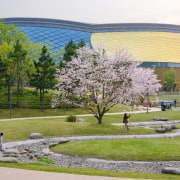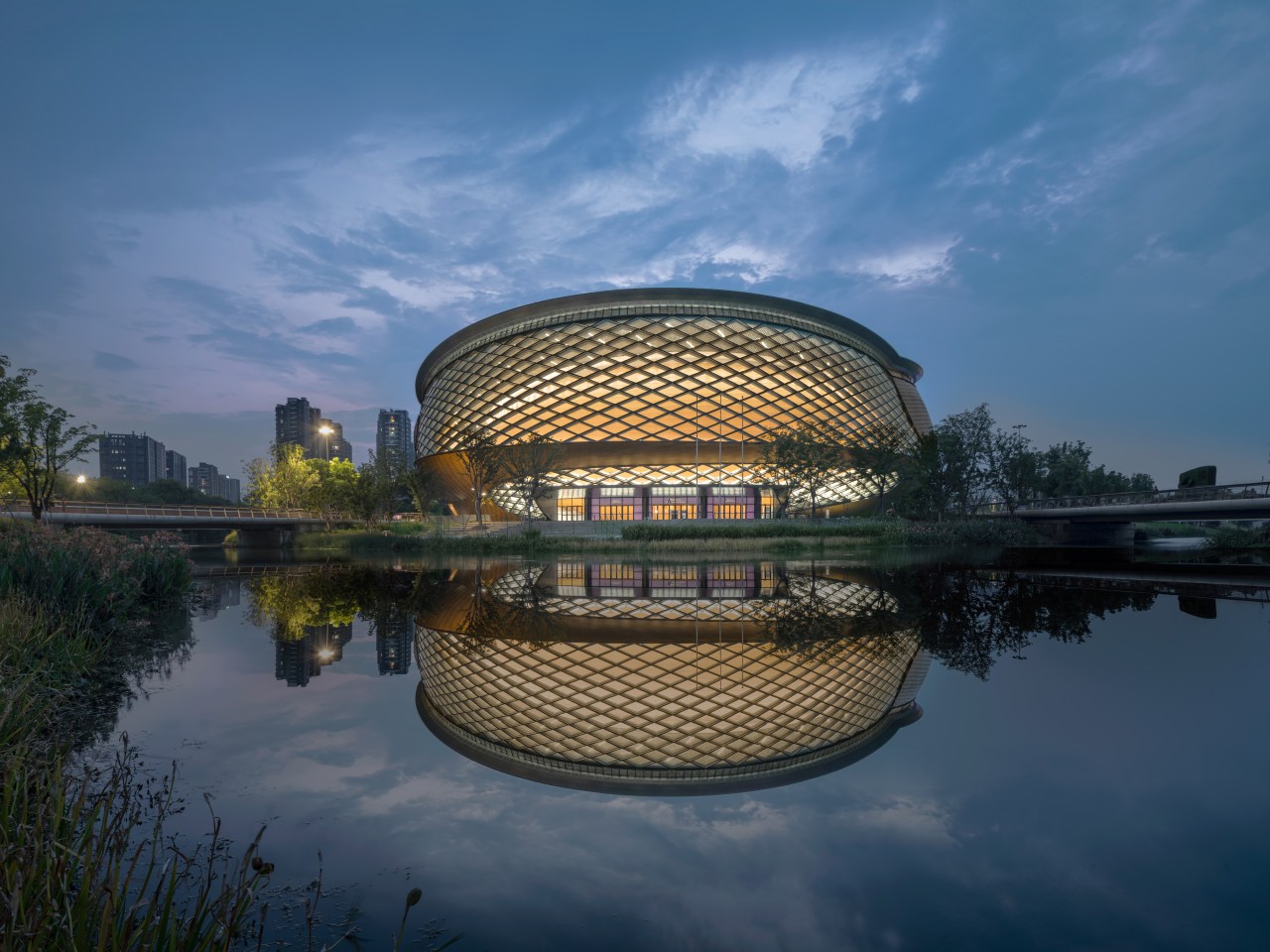Designed to bowl you over
A future-conscious Hybrid main stadium by Archi-Tectonics at the Hangzhou Asian Games 2023 Park is all set for sports now and other kinds of social productions in the future
Designed by Archi-Tectonics
From the architect:
Centerpiece of Hangzhou Asian Games 2023 Park
This 5000-seat centrepiece for the Hangzhou Asian Games 2023 Park is located at the south end of the park entrance and accessed via two curved bridges.
The 35,000m² structure is designed to function as attractor and generator of new socio-cultural activities and hence was proposed as a hybrid – merging sports events with a concert hall / event space for Hangzhou after the games – rather than being a singular stadium, it maximises legacy adaptability.
The Hybrid embodies the heritage of the region, adapting the intersecting geometry of the Cong – an ancient Jade-stone artefact in the shape of a square tube with a circular bore.
Archi-Tectonics’ parametric design study into the creation of a hybrid taxonomy (classification), two intersecting ellipses with overlapping spaces that allow for fluid connections within the interiors and connect to the exterior.
The result is a highly adaptable set of volumes that can seamlessly convert to event space after the games.
Winka Dubbeldam, founding partner of Archi-Tectonics says: "We designed the Hybrid Stadium as both an icon for the games and an active participant in Hangzhou's urban landscape that would generate new activities and uses once the games end,"
Hybrid geometry: wobbly discs
The Hybrid’s geometry was refined through multiple iterations ultimately producing the distinctive asymmetric shape.
The seating for the oblong bowl merges arena and amphitheatre seating schemes.
This makes it possible to adapt the central viewing layout preferred for sporting events into an asymmetric, stage-centred configuration for performances. The double-curved inner bowl is entirely clad in bamboo with recessed lighting and a skylight above, blending technologically generated forms with vernacular materials that offer a warm and inviting environment.
"Most stadiums are circular buildings that enclose rectangular playing fields," says Dubbeldam. "The inner and outer rings are discrete – we found that there is no ideal adaptability in that model and designed a hybrid instead.”
As they slip past each other, the disc volumes create spatial anomalies that become signature moments.
The more oblong section of the bowl hosts VIP seating lounges.
The ramps and stairs that usher visitors to the seats create layers of horizontal and vertical interconnection, transitioning from the lively city to the calm, inward-looking space of the arena.
Ramps fold up and around the bowl to get to the future theatre lounge with an outdoor roof deck overlooking the re-invigorated wetlands and eco-park landscape.
"The lobby ramps fold around each other and access entrances all along the arena’s perimeter," says Dubbeldam, 'making a multi-varient space that organises circulation in a fluid sweep.'
Secondary program areas like a sports health centre, restaurants, and VIP lounges are incorporated throughout the building, creating a layered and dynamic environment that – more than just a container for viewing sports or performances – serves as a fully equipped events and entertainment destination.
The resulting design celebrates the communal and dynamic nature of attending a cultural event, offering a multi-dimensional visitor experience.
"Everything followed from the decision to design the building as a hybrid,' says Dubbeldam. 'What was at first a provocative proposal to the client: to create a hybrid and to optimise the building for adaptability, ultimately became the driving logic of the design.
"From the intersecting volumes emerge the building’s uniquely sculptural appearance and spatial expression – It gets identity and character, becomes a new attractor and generator of new possibilities for the future of Hangzhou."
Superdrome roof – column-free interior spaces, natural light and ventilation
Archi-Tectonics engaged Thornton Tomasetti to come up with the most innovative structural solutions, including the long-span superdome roof that makes it possible for the lobby spaces to be entirely column-free, reinforcing the adaptability of the building.
The roof sits on the inner bowl and cantilevers out over the lobby to support the outer shell, a spectacular steel and glass diagrid (a framework of diagonally set beams)skin.
The roof was computationally optimised to be constructed and installed on site in just 15 segments.
Its form also facilitates the entire space being naturally lit and ventilated.
A large oculus brings natural light into the bowl, using a sculptural deflector to soften the sunlight and diffuse it evenly throughout the space.
A continuous band of operable windows below the stadium roof facilitates natural ventilation of the entrance lobby and main circulation space surrounding the inner bowl.
These windows also allow natural daylighting to enter below the cantilevered superdrome, enhancing the sensation of a floating roof.
"The building acts as an organic body, sensing the need for natural ventilation, allowing natural daylight, and the whole building is water-cooled via the new wetlands,' says Winka Dubbeldam.
Daylight also enters through the double curved diagrid glass facade, with its deep structural sections providing natural shading during the summer while the generous glazing provides natural heating during the winter – factors that greatly reduce heating and cooling loads during much of the year.
The building achieved Green Building Evaluation Label 3 Star (GBEL 3 Star), the highest level of sustainability in China and equivalent to LEED Platinum.
An integrated under-seat cooling system for the inner bowl cools the viewers, while minimising air movement – a requirement for competitive table tennis venues – while significantly reducing the cooling and heating demand.
Only the immediate area around the spectator seating is conditioned, rather than the entire air volume.
Facade – glass diagrid and brass panels
The intersecting ellipses express themselves as textured facade surfaces – one clad in brass shingles carefully calibrated to cover the doubly curved volume and the other a steel diagrid clad in planar glass.
A system of small aluminium triangles negotiates the planar glass back to the double curved diagrid.
These ‘eyelids’ also give the facade its shimmering fish scale-like appearance and lend it a sense of movement and texture.
The glass sections bend and slice through the brass shingles, creating transparent areas where daylight can enter the interiors.
Along with the long-span roof structure, this creates a light-filled, dynamic and spacious experience for visitors as they move through the building.
The glass encloses a sweeping lobby with ramps and bridges that wrap around the inner bowl.
Archi-Tectonics co-ordinated the different module dimensions to test how this impacted the cost, constructability and visual effect of the facade.
The brass shingles give a sense of depth to the facade as they negotiate the doubly curved surfaces with irregular facets.
Using BIM (Building Information Modelling), the brass system optimized its 5000 units in just 85 variations.
The final stadium design – which saved 1130 tons of steel and 1.5 million dollar in facade costs – is optimised for material efficiency and ease of construction.
The whole masterplan, the 469435m² acre park and its 7 buildings, were built in just three short years.
"We achieved an extraordinarily ambitious design on budget by working smarter, not by cutting corners," says Dubbeldam. 'We used cost-cutting measures like planar glass and the aluminium fins to give fuller expression to the design intent."
Sustainability: materials efficiency and circular construction
The building uses renewable or recycled materials, such as recycled brass for the exterior facade or bamboo cladding for the stadium interior.
All main public circulation areas – as well as the centre stadium bowl – are naturally lit and ventilated to the extent of sports regulations permitting.
The building is embedded within an Eco-Park based on sponge city design principles(s sponge city is a new urban construction model for flood management, strengthening ecological infrastructure and drainage systems, proposed by Chinese researchers), retaining, collecting, and filtering stormwater for re-use in the stadium.
Using BIM in co-ordination with the structural engineer and local fabricator, the architects arrived at a design that used as few unique modules as possible, making for efficient co-ordination with international fabricators and construction teams.
Through full BIM integration and optimisation, Archi-Tectonics and the team saved 1130 tons of steel and accelerated construction time by 20% – allowing for the building to be inaugurated a year before the start of the 2023 Asian Games.
Credit list
Project
Consultants
Architect
General contractor
Home kitchen bathroom commercial design















